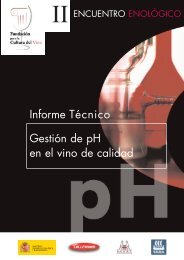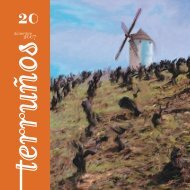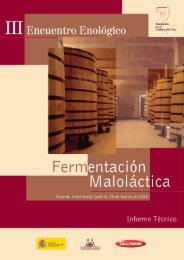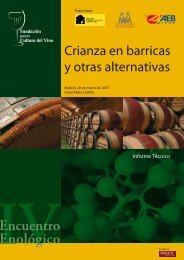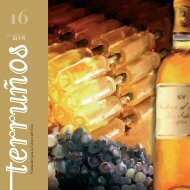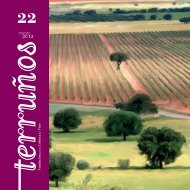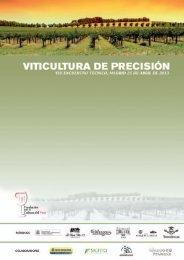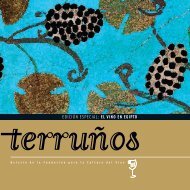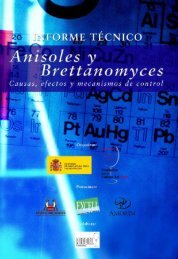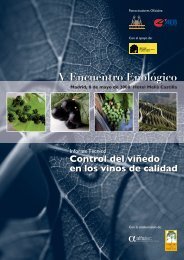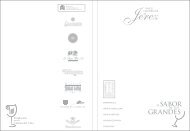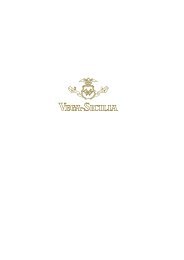Compuestos azufrados volátiles en vinos - Fundación para la ...
Compuestos azufrados volátiles en vinos - Fundación para la ...
Compuestos azufrados volátiles en vinos - Fundación para la ...
Create successful ePaper yourself
Turn your PDF publications into a flip-book with our unique Google optimized e-Paper software.
colour composition. Analytical <strong>para</strong>meters re<strong>la</strong>ted tocolour int<strong>en</strong>sity and hue were indeed found to varywith DAP supplem<strong>en</strong>tation (Ugliano et al. 2007). Thefactors responsible for this eff ect are curr<strong>en</strong>tly beinginvestigated at the AWRI. The eff ect might be ascribableto various aspects of yeast metabolism thatare known to modu<strong>la</strong>te wine colour and ph<strong>en</strong>olicscomposition. Factors include variations in the rate ofethanol production, absorption of anthocyanins onyeast cell walls (Morata et al. 2003) or reactions withyeast-derived metabolites such as pyruvic acid andacetaldehyde to form pigm<strong>en</strong>ted polymers (Romeroand Bakker 1999).CONCLUSIONThis work shows that the conc<strong>en</strong>tration of yeast assimi<strong>la</strong>bl<strong>en</strong>itrog<strong>en</strong> is not only important for <strong>en</strong>suringthat adequate yeast growth and ferm<strong>en</strong>tation kineticsare achieved, but also can aff ect the production ofthe major metabolites arising from sugar ferm<strong>en</strong>tation.Whereas ethanol conc<strong>en</strong>tration is little aff ected,that of glycerol and various carboxylic acids can bemarkedly modu<strong>la</strong>ted. These changes are likely to affect wine fl avour. Most importantly, however, is the finding that YAN can strongly infl u<strong>en</strong>ce production ofsome of the vo<strong>la</strong>tile metabolites, especially the acetateand ethyl esters, which are known to be positiveto wine aroma wh<strong>en</strong> in ba<strong>la</strong>nce. The impact of higheralcohols, which can be negative wh<strong>en</strong> pres<strong>en</strong>t in highconc<strong>en</strong>tration, can also be modu<strong>la</strong>ted by YAN. Thesevarious yeast metabolites were also found to vary inConc<strong>en</strong>tration µg/L10,0009000800070006000500040003000200010000100mg/L YAN 250mg/L YAN 400mg/L YANFatty acids ethyl estersAcetatesEthyl acetateHigher alcohols/100Figure 7. Vo<strong>la</strong>tile compounds of wines obtainedfrom low YAN (100mg/L YAN) Shiraz grapessupplem<strong>en</strong>ted with two increasing conc<strong>en</strong>trationsof DAP, to a fi nal YAN of 250mg/L and 400mg/Lrespectively. Ferm<strong>en</strong>tations were carried outat 22ºC using S. cerevisiae AWRI 796, with capplunging three times per day.Seminario Técnico<strong>Compuestos</strong> <strong>azufrados</strong> volátiles <strong>en</strong> <strong>vinos</strong>red wine ferm<strong>en</strong>tations, suggesting that, as in whitewines, must YAN can aff ect the developm<strong>en</strong>t of winefl avour. Our preliminary data suggest that wine colourand ph<strong>en</strong>olics composition can also be infl u<strong>en</strong>cedby YAN.Overall, these results suggest that, at least for Chardonnay,the fl avour and style of wine is dramaticallymodu<strong>la</strong>ted by the initial YAN conc<strong>en</strong>tration of the grapejuice. Low YAN level juices favour the production ofmore complex wines with less fruity aromas, whereasmoderate YAN levels produce cleaner and fruitier wines.However, high YAN levels can lead to excessivelyestery wines. Simi<strong>la</strong>r eff ects can be expected in othervarieties, excepting for those varieties that dep<strong>en</strong>d onthiols, for which no information is pres<strong>en</strong>tly avai<strong>la</strong>ble.Clearly, more wine s<strong>en</strong>sory studies need to be undertak<strong>en</strong>to better understand the eff ects of must YANand amino acid profi le on wine fl avour.A red wine trial is curr<strong>en</strong>tly in progress to understandbetter the impacts of managing nitrog<strong>en</strong> in the vineyardcompared with that in the winery on wine f<strong>la</strong>vour and quality. This research can be expected toprovide grapegrowers and winemakers with betterinformation for optimising wine style and quality accordingto consumer prefer<strong>en</strong>ces and other desiredoutcomes.ACKNOWLEDGEMENTSWe thank our many colleagues for supporting thisproject, especially Tracey Siebert and Dimitra Caponefor help with analysis of ferm<strong>en</strong>tation vo<strong>la</strong>tiles; Mario<strong>la</strong>Kwiatkowski and Meagan Mercurio for analysisof ph<strong>en</strong>olic compounds; Kate Lattey, Belinda Bramleyand Dr Leigh Francis for carrying out the s<strong>en</strong>soryanalyses; Industry Developm<strong>en</strong>t and Supportand Analytical Service team members for help withchemical analyses; and Dr Paul Chambers, Dr CristianVare<strong>la</strong> and Biosci<strong>en</strong>ces team members for manyhelpful discussions. Professor Francisco Carrau, ofUruguay, and visiting sci<strong>en</strong>tists Drs Diego Torrea andMar Vi<strong>la</strong>nova, from Spain, have made important contributionsto this project. We are especially grateful toMike Farmilo, of Boar’s Rock winery, for supplying a<strong>la</strong>rge number of juice samples and donating must forthe Shiraz ferm<strong>en</strong>tation trials, and Russell Johnstoneand Inca Pearce, of Or<strong>la</strong>ndo Wines, and Louisa Roseand Simon Dillon of The Yalumba Wine Company, forsupplying white wine juices. Curr<strong>en</strong>t work on nitrog<strong>en</strong>managem<strong>en</strong>t also involves col<strong>la</strong>boration with DrSally-Jean Bell and Marcel Essling. Rae B<strong>la</strong>ir is thankedfor her editorial assistance. This project is supportedby Australia’s grapegrowers and winemakers throughtheir investm<strong>en</strong>t ag<strong>en</strong>cy, the Grape and Wine Researchand Developm<strong>en</strong>t Corporation, with matchingfunds from the Australian Governm<strong>en</strong>t. The AWRI is amember of the Wine Innovation Cluster.Textos asociados69



